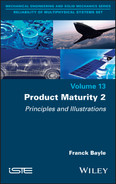List of Definitions
A
Accelerated test: a test during which the level of constraints or the frequency of their application exceeds the value corresponding to specified operational conditions, in order to reduce the time required to obtain a response to constraints.
Aggravated test: an aggravated test is an accelerated test whose guiding principle is to bring an entity to a limit (structural or operating) behavior that renders it unfit for use, submitting it to progressively but relatively rapid increased stresses.
B
Batch: a group of homogeneous products manufactured and verified under the same conditions.
Bill of materials: the list of components achieving the functions of a product.
Burn-in: a manufacturing operation that involves submitting the concerned product, after fabrication, to physical contributions (climatic, electrical and mechanical) so that latent defects are rushed into obvious defects. The objective is to eliminate the products proven defective before delivery to the customer.
Burn-in effectiveness: the effectiveness of the process = percentage of latent defects revealed by burn-in. Economic effectiveness = cost effectiveness of the process, considering its benefits.
C
Capability: the capacity of a process to achieve characteristics that meet the requirements for these characteristics.
Carrier: a set of products integrated by each equipment manufacturer (e.g. airplane, car, train, rocket, satellite and smartphone).
Component: an entity (often an electronic device) that cannot be disassembled without being destroyed or its expected use being damaged (e.g. resistors, capacitors, diodes, integrated circuits and hybrid circuits).
Coverage rate: in this book, this designates the ratio between the equipment breakage rates detected by the tests and the overall failure rate of the products.
D
Defect: in this book, this designates non-conformity to a specification.
E
Entity: designates any element, component, device, sub-product, operating unit, material unit or product that can be considered individually.
Environmental robustness: the capacity of a product to maintain its operational performances in environments more severe than those specified, in order eliminate the manufacturing and usage variability.
Equipment: in this book, this designates a set of subassemblies that achieve a function or a group of specific functions. This equipment can be a subassembly of a product.
Equipment manufacturer: a manufacturer that designs and manufactures a product based on specifications. For example, in the automotive field, VALEO can be considered an equipment manufacturer.
F
Failure: the loss of the ability to function as required.
Failure mechanism: the physical process driving a failure.
Final user: a private person or professional using a product sold by a system manufacturer. For example, in the automotive field, any person that owns a Renault vehicle can be considered the final user.
L
Latent failure: a failure that is not observable.
Level of constraint: in this book, this designates the amplitude of the constraint.
Lifecycle: a series of identifiable manufacturing stages that an entity goes through, from its design to its disposal. For example, the classical lifecycle of a product comprises the following stages: feasibility and definition, design and development, manufacturing and putting into service, exploitation and maintenance, renovation during life time or service life extension and retirement or disposal.
M
Manufacturing: in this book, this designates an action or way to manufacture or produce products in an industrial manner.
Maturity: the state of a product that guarantees the expected reliability level, since it is put into operational service.
N
Non-conformity: the failure to meet a requirement.
O
Operating life: the time the product is used by the final customer.
Operational robustness: the capacity of a product to achieve operational performances that are above those required in the specified environments.
Operational test: designates the verification of critical parameters to guarantee the proper operation of a product.
P
Physical contributions: physical constraints refers to any physical quantity, normally applied to the product during its operational use or for tests, including the relevant aspects of design. Physical constraints are grouped into various families: thermal, electrical, thermal cycling, mechanical, humidity and chemical.
Product: the assembled entity whose reliability is studied. Generally, equipment.
Production: in this book, this designates the amount of products manufactured throughout a given period or during a manufacturing cycle.
Q
Quantile: the quantiles of a univariate, discrete or continuous variable are the values taken by the variable for probability values below the considered quantile, having a remarkable value, for example 3 tenths or 5 hundredths. They are also known as fractiles, a complete synonym depending on the context of usage, and they are the reciprocal values of the distribution function of the law of probability.
R
Requirement: a formulated need or expectation, usually implicit, or imposed.
Robustness: the capacity of a product to display performances that are above those required in specified environments.
Robustness margins: the difference of level of a physical contribution between the specification and the observed operational or environmental limit.
Run-in: process conducted with the sole intention to stabilize the parameters.
NOTE.– A run-in is accelerated conditioning, which is achieved by getting the entity to operate under its operating electrical charge at a high temperature, which is generally the maximal operating temperature compatible with the assigned thermal characteristics of the device.
S
Sampling: in this book, this designates the samples of production used to verify the conformity of specifications.
Service life: the time until a certain percentage of aging failures (0.1%, 1% or 10%) is observed.
System manufacturer: a manufacturer specifying a product to an equipment manufacturer and integrating it in its carrier. For example, in the automotive field, RENAULT can be considered a system manufacturer.
T
Test: in this book, this designates a method subjecting an element to studied conditions, in order to define if this element meets its specifications.
Test in combined environment: in this book, this designates an environmental test during which several constraints are applied simultaneously.
Testability: the measure of the easiness with which an entity can be tested.
